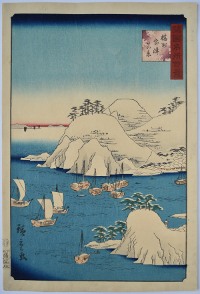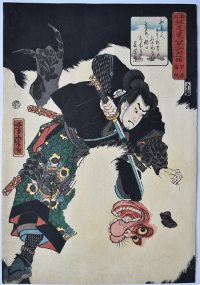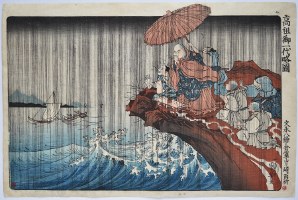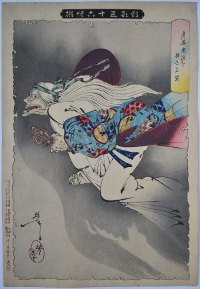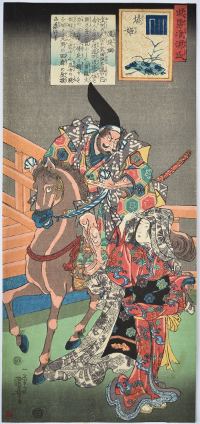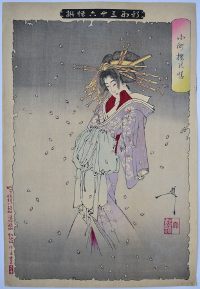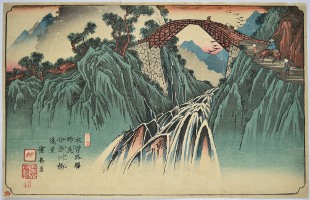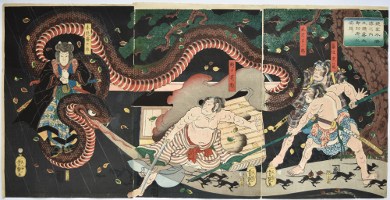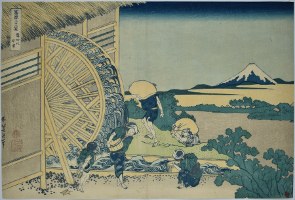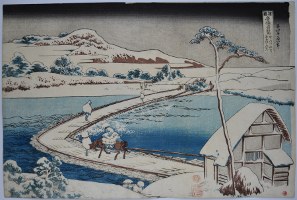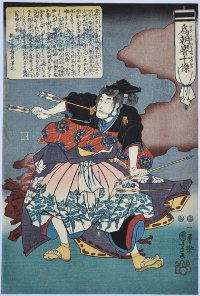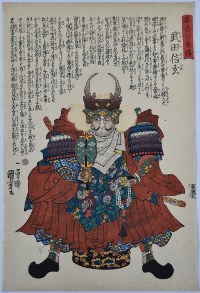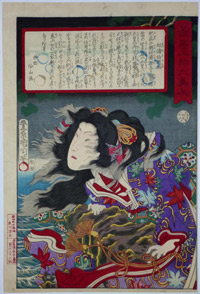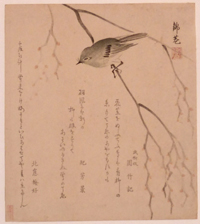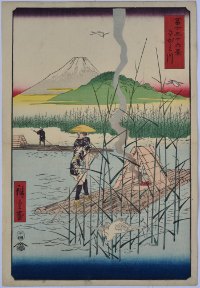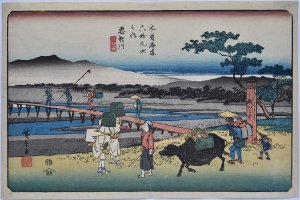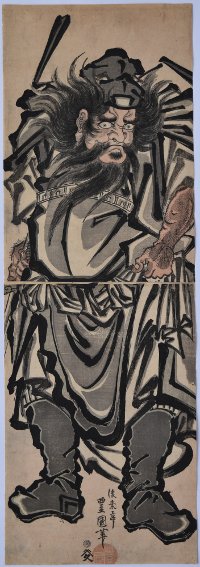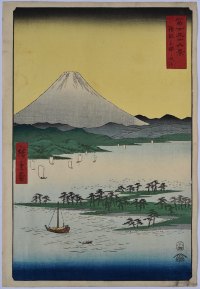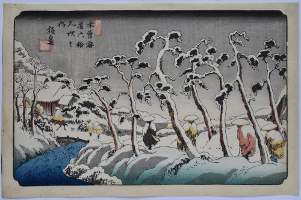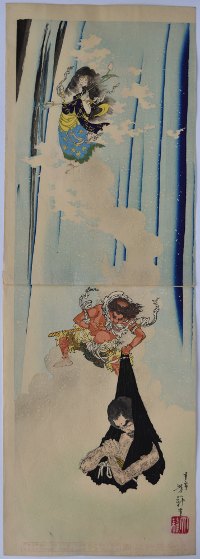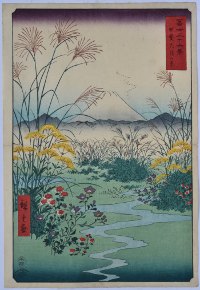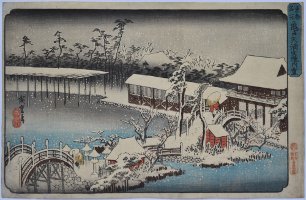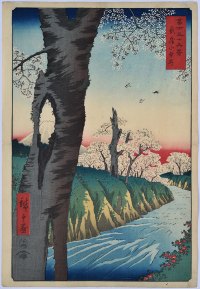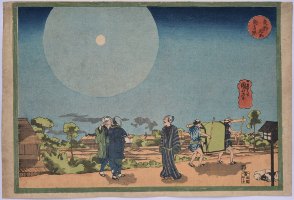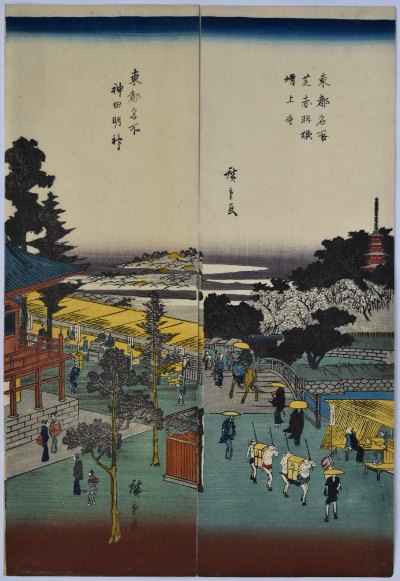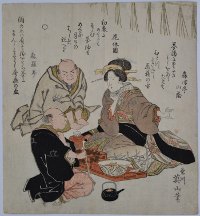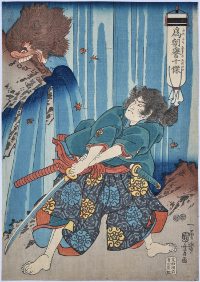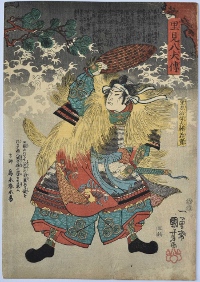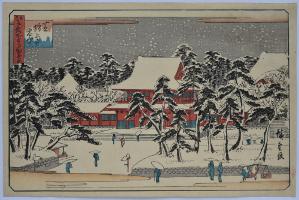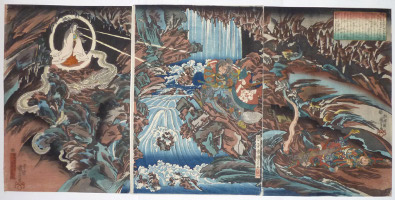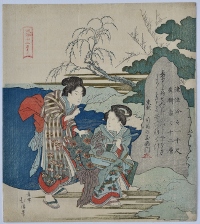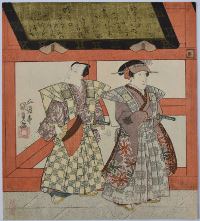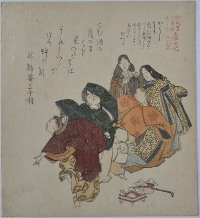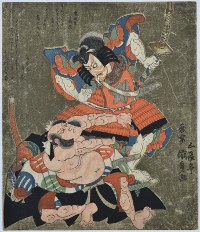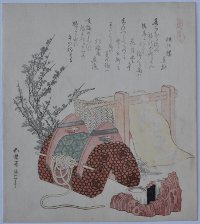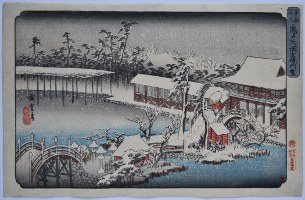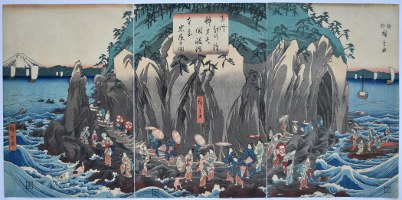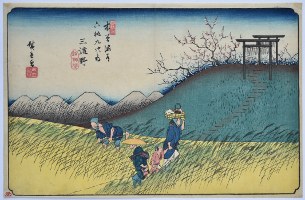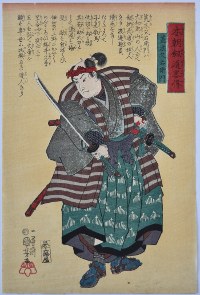Utagawa HIROSHIGE II (1826-1869)
Click here to view image full size.
A true view of Muro Harbour in Harima Province, Banshu Muro-no-tsu, from Shokoku meisho hyakkei, “One Hundred Famous Views in the Various Provinces.” The set published by Uoya Eikichi, 1859-61 (this being 1859).
Superb impression of the first edition. Fine colour. Small backed binding holes in right margin, otherwise fine condition. Signed Hiroshige ga.
Status: Sold
Utagawa YOSHITORA (Active 1836-87)
Click here to view image full size.
Uji Joetsu killing a huge monster with a long-haired albino coat and giant claws. From a set: Honcho kendo tatsujin hyakunin no uchi hitori, “A Hundred Great Swordsmen of Our Country.” Published by Itoya Fukujiro, 1859.
Fine impression. The monster’s coat completely blind-printed. Fine colour. Slightly trimmed, otherwise very good condition. Signed Yoshitora ga.
Status: Sold
Utagawa KUNIYOSHI (1797-1861)
Click here to view image full size.
The priest Nichiren standing on the rocky promontory at Reizan in Kamakura and having his prayers for rain answered. The event occurred in 1271. His disciples surround him and protect him from the deluge with a large umbrella. Bunei hachi Kamakura Reizan-ga-saki uki. The second best design from Koso [ Nichiren ] goichidai ryakuzu, “Illustrated Abridged Biography of the Founder.” Nichiren ( 1222 – 1282 ) was the founder of the Buddhist Nichiren sect ( Nichiren shu – Kuniyoshi being a follower ) and indeed the set of ten prints may have been commissioned to mark the 550th anniversary of his death. Published by Iseya Rihei c 1831.
Fine impression and colour. Small repaired binding holes in right margin, otherwise fine condition. Full size with ample room on top border for the umbrella which protrudes beyond the border and is notorious for being trimmed. Signed Ichiyusai Kuniyoshi ga.
Status: Sold
Taiso YOSHITOSHI (1839-1892)
Click here to view image full size.
Roba kiwan o mochisaru from Shingata sanjurokkaisen, “New Forms of Thirty-Six Ghosts.” The set of thirty-six prints published by Sasaki Toyokichi 1889-1892 (this being 1889). Shows the demon Ibaraki escaping with her severed arm. She had haunted the Rashomon Gate near the Toji Temple in Kyoto. Watanabe no Tsuna is commanded to kill her but only succeeds in cutting an arm off. Knowing she will return he locks it in a box. Subsequently his elderly aunt visits him and asks to see it, whereupon she reverts to her demonic self and seizes the limb. In another version she haunts the Modori bridge, Ichijo, in Kyoto.
Very fine impression of the first edition with burnishing. Fine colour. Very slight crease, otherwise fine condition. Signed Yoshitoshi.
Status: Sold
Utagawa KUNIYOSHI (1797-1861)
Click here to view image full size.
Hashihime from Buyu nazoraye Genji, “Heroic Comparisons for the Chapters of Genji.” Shows Watanabe no Tsuna on horseback and the demon-woman Ibaraki at the Modori bridge, Ichijo, Kyoto. An o-tanzaku set published by Iba-ya Sensaburo, c 1843. The fifty-four Chapters of Genji, the Genji Monogatari, was a tenth century romance by Murasaki-Shikibu. In this version of the story Watanabe is enchanted by a beautiful young woman, but his suspicions are aroused and then confirmed when he sees her reflection in the river which reveals her true demonic self. The outcome of this version is the same with Ibaraki’s arm being cut off.
Very fine impression, colour and condition. Signed Ichiyusai Kuniyoshi ga.
Status: Sold
Taiso YOSHITOSHI (1839-1892)
Click here to view image full size.
Komachizakura no sei from Shingata sanjurokkaisen, “New Forms of Thirty-Six Ghosts.” The set of thirty-six prints published by Sasaki Toyokichi 1889-1892 (this being 1889). The story relates how Lord Kuronushi is on his way to attempt the overthrow of the Emperor. To make his journey auspicious he stops to build a shrine using an ancient cherry tree. The spirit of the cherry tree appears in the form of Kurozume – a courtesan with magical powers. She extracts the details of the plot and punishes him.
Very fine impression of the first edition with burnishing. Fine colour. Very slight crease, otherwise fine condition. Signed Yoshitoshi.
Status: Sold
Keisai EISEN (1790-1848)
Click here to view image full size.
The bridge over the Ina River at Nojiri, Nojiri Inagawabashi enkei, from Kisokaido rokujukyutsugi no uchi , “Sixty-Nine Stations of the Kisokaido.” The set of seventy prints was published by Hoeido in 1835, but in 1837 Hiroshige took over and completed the series with the publisher Iseya Rihei (Kinjudo). The conjecture is that Hiroshige was the better known and more commercial artist, reinforced by the fact that Eisen’s name was removed from the designs already published. Hence only the first editions have his signature on those prints. Shows the cascade beneath the bridge, the underside of which resembles Mount Fuji. Top left, just visible in the mist, are the steps leading to the Kiyomizu Temple of Kiso. (Now a world heritage site, famous for the wooden stage jutting out over the mountainside supported by 139 12-meter high keyaki wood pillars.) One of the best designs from the set. Provenance: Ex Grabhorn collection.
Fine impression. Extremely rare in this early printing: There are a number of different states with alternative colouring to the hills, variant gradation below the falls, losing the blue mountains in the distance and without the flight of geese behind the bridge. Only the first edition has the geese, the blue mountains and the Eisen signature (as here). Fine colour. Margins trimmed a little, otherwise very good condition. Signed Keisai ga.
Status: Sold
Ichieisai YOSHITSUYA (1822-1866)
Click here to view image full size.
A dramatic triptych: Kyokyaku Suikoden no uchi: Kogakure no Kiritaro yojutsu o motte sugata o kakasu. The Kyokyaku Suikoden: Kogakure no Kiritaro hiding himself by using witchcraft. The snake, with Kiritaro standing on him, has emanated from the kago in the centre sheet to the confusion of the three attackers: Waniguchi Jinsuke (centre) and Masakino Torazo and Kazama Hanjiro. A stream of rats is emitted from the snake’s mouth. I have not been able to source this story. Published by Kameya Iwakuchi, 1861. Rare.
Fine impression. Very good colour. Sumi marks au verso showing through slightly, otherwise very good condition. Signed Ichieisai Yoshitsuya ga.
Status: Sold
Katsushika HOKUSAI (1760-1849)
Click here to view image full size.
Onden no suisha, “Waterwheel at Onden” from the set Fugaku sanju-rokkei, the “Thirty-Six Views of Fuji.” The series published by Eijudo between 1829-33 and extended to forty six prints. These extra designs have a black outline, whereas the first thirty six have blue outlines in the early editions and then black. Shows the mill with men carrying bags of rice to be milled. A woman washes vegetables, another carries a tub and a small child drags a terrapin. Onden was on the Shibuya river, between Harajuko and Aoyama. (The river now hidden from view under the concrete sprawl of Tokyo.) Evidently waterwheels dotted the area powered by the Shibuya river.
Fine impression and colour. (Collectors are often unaware that designs from this set are faded: The yellow part of the green fades, leaving blue. And because there are designs that are only printed in blue or are blue in the early states, they accept them as unfaded.) Trimmed left and top and slight centre fold, otherwise very good condition. Signed Zen Hokusai I-itsu hitsu.
Status: Sold
Katsushika HOKUSAI (1760-1849)
Click here to view image full size.
Kozuke Sano funabashi no kozu, “Old View of the Pontoon Bridge at Sano, Kozuke Province.” From a set of eleven prints, Shokoku meikyo kiran, “Wondrous Views of Famous Bridges in All the Provinces.” A snow scene showing travellers, one on horseback, traversing the pontoon bridge built of boats. Published by Nishimuraya Yohachi, 1831-2.
Very good impression. Some slight fading. Very good condition. Full size. Signed Zen Hokusai Iitsu hitsu.
Status: Sold
Utagawa KUNIYOSHI (1797-1861)
Click here to view image full size.
Tametomo at the age of thirteen catching the arrows shot at him by two of the Emperor’s guard in a competition with Shonagon Nyudo Shinsei. From a set: Tametomo homare no jikketsu, “Ten Famous Excellencies of Tametomo.” The set published by Aritaya Seiyemon, c 1848-51.
Extremely fine impression, colour and condition. Signed Ichiyusai Kuniyoshi ga.
Status: Sold
Utagawa KUNIYOSHI (1797-1861)
Click here to view image full size.
Takeda Shingen seated and holding a war-fan and rosary and fully armoured. From a series: Meiko hyaku yu den, “Stories of a Hundred Heroes of High Renown” published by Idzumiya Ichibei, 1843-4.
Very fine impression, fine colour and condition. Signed Ichiyusai Kuniyoshi ga.
Status: Sold
Toyohara KUNICHIKA (1835-1900)
Click here to view image full size.
The devoted wife Sayohime from Thirty-six Good and Evil Beauties.” She is seen on a rocky outcrop watching her husband Otomo Sadehiko sail away to war. Legend has it that she wept for so long that she eventually turned to stone. The figure being referred to as Bofu-seki, “Weeping-wife Stone.” Published by Fukuda Kumajiro, 1876.
Very fine impression of the first edition . Small backed wormhole top margin and small thinned area, otherwise fine condition. Signed Yasohachi Kunichika hitsu.
Status: Sold
KINKO
Click here to view image full size.
A surimono of what may be a Japanese bush warbler ( uguisu ), the harbinger of spring, perched on a weeping cherry branch.Three poems below.
Fine impression and colour. Slight signs of mounting au verso, otherwise very good condition. Signed and sealed Kinko. Seal of engraver Shiho Sanshi bottom left.
Status: Sold
Ichiryusai HIROSHIGE (1797-1858)
Click here to view image full size.
Sagamigawa, “The Sagami River” Sagami Province. Rafts being poled down the river with tall water reeds and herons from Fuji sanjurokkei, “Thirty-six Views of Fuji” published by Tsutaya Kichizo, 1858. This set was started 5 months before Hiroshige’s death. Early impressions, as here, were printed very carefully as a tribute to Hiroshige. One of the six best designs from the set.
Fine, early impression. Perfect colour. Imperceptible centre fold, otherwise fine condition. Signed Hiroshige ga.
Status: Sold
Ichiryusai HIROSHIGE (1797-1858)
Click here to view image full size.
Echikawa from Kisokaido rokujukyutsugi no uchi, “Sixty-Nine Stations of the Kisokaido.” The set of seventy prints was started by Eisen and published by Hoeido in 1835, but in 1837 Hiroshige took over and completed the series with the publisher Iseya Rihei (Kinjudo). Shows the Echi river with a trestle bridge crossing it. In the foreground a laden oxen being led and two peripatetic priests.
Fine impression and colour. Imperceptible centre fold, otherwise very good condition. Signed Hiroshige ga.
Status: Sold
Utagawa TOYOKUNI II (TOYOSHIGE) (1777-1835)
Click here to view image full size.
A vertical diptych of Shoki, the Demon Queller. The character originates from China being a deity from China’s Taoist pantheon. He is always shown with his scholar’s hat, large robe and boots, and usually carrying a sword with which he attacks oni. Images of Shoki were hung outside houses to ward off evil during the Boys’ Day Festival on May 5th. Published by Yamamoto Kyubei, c 1820. Prints by Toyoshige are often misattributed to Toyokuni I and vice versa because late Toyokuni I signatures and those of Toyoshige are similar. Rare.
Very good impression and colour. Some edge soil, otherwise very good condition. Signed Gosotei Toyokuni hitsu.
Status: Sold
Ichiryusai HIROSHIGE (1797-1858)
Click here to view image full size.
Suruga Miho no Matsubara. Shows the famous Pine Beech, Suruga Province. from Fuji sanjurokkei, “Thirty-six Views of Fuji” published by Tsutaya Kichizo, 1858. This was considered to offer one of the best views of Fuji.The set was started 5 months before Hiroshige’s death. Early impressions, as here, were printed very carefully as a tribute to Hiroshige. One of the six best designs from the set.
Fine, early impression. Perfect colour. Imperceptible centre fold and small soil in bottom right margin, otherwise fine condition. Signed Hiroshige ga.
Status: Sold
Keisai EISEN (1764-1824)
Click here to view image full size.
Itahana from Kisokaido rokujukyutsugi no uchi, “Sixty-Nine Stations of the Kisokaido.” The set of seventy prints was started by Eisen and published by Hoeido in 1835, but in 1837 Hiroshige took over and completed the series with the publisher Iseya Rihei (Kinjudo). One of the best designs from the set. This design is never signed, even, as here, on the first edition. Rare.
Fine impression and colour. This is the first edition with gradation on the river and the river bank. Fine condition.
Status: Sold
Taiso YOSHITOSHI (1839-1892)
Click here to view image full size.
A vertical diptych: Mongaku shonin aragyo no zu. One of a series of 16 vertical diptychs published in the 1880s. Shows the priest Mongaku atoning for his sins in the icy waters of the Nachi waterfall but being saved just in time by Seitaka doji, one of the two main boy servants of the Buddhist guardian deity Fudo-myoo (shown above). Published by Matsui Eikichi, 1885.
Very fine impression. Fine colour. The first edition with the title printed in red at the bottom. On thick deluxe hosho. Slight bleeding of the red seal, otherwise fine condition with the extra paper at left and top. Signed Oju Yoshitoshi ga.
Status: Sold
Ichiryusai HIROSHIGE (1797-1858)
Click here to view image full size.
Kai Otsukinohara, the Otsuki Plain in Kai Province. A meandering stream with flowers and pampas grass from Fuji sanjurokkei, “Thirty-six Views of Fuji” published by Tsutaya Kichizo, 1858. This set was started 5 months before Hiroshige’s death. Early impressions, as here, were printed very carefully as a tribute to Hiroshige. One of the six best designs from the set.
Fine, early impression. Perfect colour. Imperceptible centre fold, otherwise fine condition. Signed Hiroshige ga.
Status: Sold
Ichiryusai HIROSHIGE (1797-1858)
Click here to view image full size.
The compound of the Tenman Shrine at Kameido, Kameido Tenmangu keidai no yuki. The best design from a Toto meisho set of 21 prints published by Kikakudo (Sanoki) c 1832-5 and then extended to 55 in c. 1839-42. Also one of the best known places in Edo with the Drum Bridge, koi ponds and wisteria which flowered in the Fifth Month. The main shrine is dedicated to the memory of Sugawara no Michizane (Tenjin), the father of Japanese learning and built in 1662. Hiroshige shows the shrine in winter under falling snow.
Fine early impression with the red publisher’s seal in right margin (later editions having the black seal of Sanoki). These later editions have a black sky and a block defect appears at the edge of the pond centre left. Fine colour. Small restoration bottom left corner, otherwise very good condition. Signed Hiroshige ga.
Status: Sold
Ichiryusai HIROSHIGE (1797-1858)
Click here to view image full size.
Musashi Tamagawa, “Tama River, Musashi” Musashi Province. A view from Koganei with flowering cherry trees from Fuji sanjurokkei, “Thirty-six Views of Fuji” published by Tsutaya Kichizo, 1858. This set was started 5 months before Hiroshige’s death. Early impressions, as here, were printed very carefully as a tribute to Hiroshige. One of the six best designs from the set.
Fine, early impression. Perfect colour. Imperceptible centre fold, otherwise fine condition. Signed Hiroshige ga.
Status: Sold
Utagawa KUNIYOSHI (1797-1861)
Click here to view image full size.
The Shin Yoshiwara from a Toto meisho “Famous Views of the Eastern Capital” set of 10 prints published by Kagaya Kichibei, c. 1831. The “Shin” or “New” Yoshiwara was so named after its relocation after a fire in 1657. It can be seen in the distance. In the foreground are late night travellers on the Nihon embankment. The scene is dominated by the moon and its huge halo. The set uses Europeanised elements, most evident in his landscape prints as well as a few other series and some surimono. Extremely rare.
Fine impression and colour. Another state has a line printed around the moon. The green border intact which is rare on this set as it is often trimmed, sometimes completely. Slight soil, otherwise very good condition. Signed Ichiyusai Kuniyoshi ga.
Status: Sold
Ichiryusai HIROSHIGE (1797-1858)
Click here to view image full size.
Two tanzaku prints from a Toto meisho “Famous Places of the Eastern Capital” set that were printed two-to-a-sheet. They were cut down the middle but in this case the two prints were kept together which is extremely rare. On the left: Kanda Myoujin, “Kanda Shrine.” On the right: Shiba Akabane Zojoji, “Shiba Akabane Zojoji Temple.” Published c 1840.
Very good impression, colour and condition. Signed Hiroshige ga.
Status: Sold
Kikugawa EIZAN (1787-1867)
Click here to view image full size.
A surimono showing a game of rock-paper-scissors, although this might be a variant called Kitsune-ken, with fox-hunter-village chief. The game originates (as so much in Japan) from China and eventually made its way to the west. This was (and is) a dangerous game to play with ladies who entertained as they seldom lost. Published c 1820s. Eizan designed few surimono and this is rare.
Fine impression. Very good colour and condition. Signed Kikugawa Eizan hitsu.
Status: Sold
Ichiryusai HIROSHIGE (1797-1858)
Click here to view image full size.
Izu no sanchu, “In the Mountains, Izu” the Joren Falls flow down between hills from Fuji sanjurokkei, “Thirty-six Views of Fuji” published by Tsutaya Kichizo, 1858. This set was started 5 months before Hiroshige’s death. Early impressions, as here, were printed very carefully as a tribute to Hiroshige. One of the six best designs from the set.
Fine, early impression. Perfect colour. Imperceptible centre fold, otherwise fine condition. Signed Hiroshige ga.
Status: Sold
Utagawa KUNIYOSHI (1797-1861)
Click here to view image full size.
Minamoto Tametomo (1139-70) decapitating Yamaotoko from a set of ten prints: Tametomo homare no jikketsu, “Ten Famous Glories of Tametomo.” A great archer (it being said that his left arm was four inches longer than his right), and a wild and colourful character. The story shown here relates how Tametomo, while exiled to the island of Izu Oshima, discovers a nearby island inhabited by creatures with a demon-like countenance, red faces and long red hair hanging over their foreheads. He eventually subjugates the devils and is regarded as a king by the islanders. Published by Aritaya Seiemon, 1847-50.
Fine impression, colour and condition. Signed Ichiyusai Kuniyoshi ga.
Status: Sold
Utagawa KUNIYOSHI (1798-1861)
Click here to view image full size.
Satomi Jibu-no-taifu Yoshizane, a daimyo in control of Takita Castle from Satomi Hakkenden, the eight heroes of Bakin’s novel Hakkenden. Published by Mikawa-ya Tetsugoro, c 1849-51. See the Kunichika triptych of the same subject on this current selection.
Very good impression, colour and condition. Signed Ichiryusai Kuniyoshi ga.
Status: Sold
Ichiryusai HIROSHIGE (1797-1858)
Click here to view image full size.
Shiba Zojoji setchu, “Snow at Zojoji Temple” from a set Edo meisho mitu no nagame, “Three Special Views of Edo” published by Uoya Eikichi, c 1840-42. The temple, together with Kan’ei-ji, was the Tokugawa’s family temple. Rare.
Fine impression, colour and condition. Signed Hiroshige ga.
Status: Sold
Utagawa KUNIYOSHI (1798-1861)
Click here to view image full size.
Nitta Tadatsune encountering the goddess of Mount Fuji and her dragon in a cavern with numerous stalactites and a fast flowing river and waterfall. She complimented Tadatsune on his courage while his compatriots were stricken with terror. Statues of the goddess Kwannon ( Chin: Guanyin ) are often found in caves. Published by Tsuji-ya Yasubei, c. 1844. Robinson T143. A fine design.
Very good impression, colour and condition. Signed Ichiyusai Kuniyoshi ga.
Status: Sold
Totoya HOKKEI (1780-1850)
Click here to view image full size.
A surimono showing two beauties by the pond at Tsunowazu Kumano Shrine in Yotsuya. The title is: Yotsuya Juniso, referring to the twelve shrines at Tsunowazu in Yotsuya. The poem on the large stone is by Shibanoya and refers to the peacefulness of the place with the willows and water. The other writing directs visitors to the cool of the nearby waterfall and the Unju forrest.
Fine impression with silver and gold. Fine colour and condition. Signed on request, Motome ni ojite Hokkei fude.
Status: Sold
Utagawa KUNISADA (1785-1865)
Click here to view image full size.
A surimono showing the actors Ichikawa Monnosuke III (right) and Ichikawa Danjuro VII walking in the emado of Asakusa Temple in Edo. This was a pavilion at the Shinto shrine used for displaying votive tablets. This seems to be part of a three or five sheet set showing a continuous procession of Ichikawa actors at the shrine. Provenance: From my Catalogue 15, 1975, no. 67.
Fine impression with extensive gold and silver. Fine colour and condition. Signed Gototei Kunisada ga.
Status: Sold
Kubo SHUMMAN (1757-1820)
Click here to view image full size.
A surimono showing court figures dancing from a series: Shofudai Hisakataya Bunbunsha Tosa Nikki, “The Tosa Diary for the Shofudai, Hisakataya and Bunbunsha Poetry Groups.” Issued late 1810s. For another from this series see: Jewels Of Japanese Printmaking: Surimono Of The Bunka-Bunsei Era 1804-1830, Joan B. Mirviss, Ota Memorial Museum of Art, 2000, no. 85, p. 131. Rare: Possibly the only known impression.
Fine impression. Very good colour. Lightly backed, otherwise very good condition. Artist’s seal Sho Shumman.
Status: Sold
Utagawa KUNISADA (1785-1865)
Click here to view image full size.
A surimono showing Ichikawa Danjuro VII and Bando Mitsugoro III as Soga no Goro and Asahina no Saburo in the armour-pulling (kusazuri-biki) scene from the play Tsukisenzu haru gohiki Soga. Issued 1827. The story relates how Soga no Goro was feasting at a banquet when he learns of a plot to assassinate his brother, Juro. He rushes off to don his armour. Asahina, the liege of his enemy, tries to prevent him by pulling at his armour. Poems by Yukinoya Takane and Hoshitei Masunari. Rare.
Fine impression with extensive silver and gold. A gold ground. Fine colour. Some loss of the gold ground as is the case with other known impressions of this surimono. This appears to be the best preserved copy. Very good condition. Signed Oju Gototei Kunisada ga.
Status: Sold
Katsushika HOKUSAI (1760-1849)
Click here to view image full size.
A surimono, Umazakushi, showing a saddle and cotton-gin from Watakuri uma, “A Series of Horses.” Issued for the Yomogawa club, 1822. Shows a horse’s saddle, a cotton-gin, basket of cotton floss and a branch of plum. A smoking set in the foreground. This set followed on from the success of the Shell surimono series issued in 1821. Twenty eight designs are known. The title (in a red gourd) top right is hand-stamped. Rare.
Fine impression with silver, gold and blind-printing. Fine colour. Minor soil, otherwise very good condition. Signed Fusenkyo Iitsu hitsu.
Status: Sold
Ichiryusai HIROSHIGE (1797-1858)
Click here to view image full size.
The compound of the Tenman Shrine at Kameido, Kameido Tenmangu keidai no yuki. The best design from a Toto meisho set of 21 prints published by Kikakudo (Sanoki) c 1832-5 and then extended to 55 in c. 1839-42. Also one of the best known places in Edo with the Drum Bridge, koi ponds and wisteria which flowered in the Fifth Month. The main shrine is dedicated to the memory of Sugawara no Michizane (Tenjin), the father of Japanese learning and built in 1662. Hiroshige shows the shrine in winter under falling snow.
Fine early impression with the red publisher’s seal in right margin (later editions having the black seal of Sanoki). These later editions have a black sky and a block defect appears at the edge of the pond centre left. Fine colour. Signed Hiroshige ga.
Status: Sold
Ichiryusai HIROSHIGE (1797-1858)
Click here to view image full size.
Soshu Enoshima Benzaiten kaicho mode Hongu Iwaya no zu, “Pilgrimage to the Cave Shrine of Benzaiten on Enoshima.” A triptych showing the back view of the island (the causeway being on the other side) with the Iwaya cave on the right. Groups of women from Edo schools of narrative chanting are seen with umbrellas (Benzaiten was a deity associated with music). The statue was displayed once every six years. Published by Sumiyoshi Masagoro, 1851.
Fine impression. Very good colour. Fine condition. Signed Hiroshige ga.
Status: Sold
Ichiryusai HIROSHIGE (1797-1858)
Click here to view image full size.
Midono from Kisokaido rokujukyutsugi no uchi , “Sixty-Nine Stations of the Kisokaido.” The set of seventy prints was published by Hoeido in 1835, but in 1837 Hiroshige took over and completed the series with the publisher Iseya Rihei (Kinjudo). The conjecture is that Hiroshige was the better known and more commercial artist, reinforced by the fact that Eisen’s name was removed from the designs already published. Hence only the first editions have his signature on those prints. Shows travellers in a field of pampas grass and a farm worker with a hoe to the left. On the hill above are torii gates leading to a Shinto shrine. The area here opens out after the narrow Kiso valley and is popular with walkers today. Provenance: Ex Grabhorn collection.
Fine impression of the earliest state with bokashi on the brow of the hill. Fine colour. Slight centre fold, otherwise very good condition. Signed Hiroshige ga.
Status: Sold
Utagawa KUNIYOSHI (1797-1861)
Click here to view image full size.
Araki Matayemon standing, examining his sword from Honcho kendo ryaku den, “Abridged Stories of Our Country’s Swordsmanship.” The set published by Kadzusaya Iwazo in c 1845-6.
Extremely fine impression, colour and condition. Solid yellow ground. Signed Ichiyusai Kuniyoshi ga.
Status: Sold
